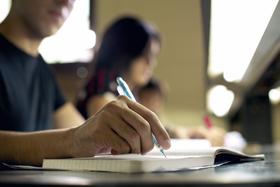Alternative High School serves 145 students in grades 9-12.
The percentage of students achieving proficiency in reading/language arts is <50% (which is lower than the Texas state average of 73%).
The student-teacher ratio of 4:1 is lower than the Texas state level of 14:1.
Minority enrollment is 86% of the student body (majority Hispanic), which is higher than the Texas state average of 75% (majority Hispanic).
Quick Facts (2025-26)
- School Type: Alternative school
- Grades: 9-12
- Enrollment: 145 students
- Student-Teacher Ratio: 4:1
- Minority Enrollment: 86%
- Reading Proficiency: <50%
- Source: National Center for Education Statistics (NCES), TX Dept. of Education
Top Rankings
Alternative High School ranks among the top 20% of public schools in Texas for:
Category
Attribute
Community Size
Student Attention
School Overview
Alternative High School's student population of 145 students has stayed relatively flat over five school years.
The teacher population of 34 teachers has grown by 47% over five school years.
School Type
Grades Offered
Grades 9-12
Total Students
145 students
Gender %
Total Classroom Teachers
34 teachers
Year Founded
1982
Last Day of School
Thu. May 21, 2026
School Motto
Provide a safe and structured environment to transform the learning experience for students.
School Rankings
The diversity score of Alternative High School is 0.39, which is less than the diversity score at state average of 0.64. The school's diversity has stayed relatively flat over five school years.
Reading/Language Arts Test Scores (% Proficient)
(14-15)<50%
73%
Student-Teacher Ratio
4:1
14:1
American Indian
n/a
n/a
Asian
2%
6%
Hispanic
77%
53%
Black
4%
13%
White
14%
25%
Hawaiian
1%
n/a
Two or more races
2%
3%
All Ethnic Groups
Participates in the National School Lunch Program (NSLP)
Yes
Eligible for Free Lunch
62%
57%
Eligible for Reduced Lunch
3%
5%
School Statewide Testing
School District Name
Source: National Center for Education Statistics (NCES), TX Dept. of Education
Profile last updated: 02/09/2025
Frequently Asked Questions
How many students attend Alternative High School?
145 students attend Alternative High School.
What is the racial composition of the student body?
77% of Alternative High School students are Hispanic, 14% of students are White, 4% of students are Black, 2% of students are Asian, 2% of students are Two or more races, and 1% of students are Hawaiian.
What is the student-teacher ratio of Alternative High School?
Alternative High School has a student ration of 4:1, which is lower than the Texas state average of 14:1.
What grades does Alternative High School offer ?
Alternative High School offers enrollment in grades 9-12
What school district is Alternative High School part of?
Alternative High School is part of Northside Independent School District.
In what neighborhood is Alternative High School located?
Alternative High School is located in the Far West Side neighborhood of San Antonio, TX. There are 73 other public schools located in Far West Side.
School Reviews
Review Alternative High School. Reviews should be a few sentences in length. Please include any comments on:
- Quality of academic programs, teachers, and facilities
- Availability of music, art, sports and other extracurricular activities
Recent Articles

Public School Open House & Enrollment Season Guide
A parent-focused guide to the public school open house and enrollment season, with expert questions, timelines, and decision tips.

School Supply Budget 2026: Fees, Books, Tech Costs
School Supply Budget 2026 guide for parents, covering fees, textbooks, technology, and hidden extras to plan ahead.

Education Funding in America (2025 Update)
Comprehensive 2025 update on public school funding in America, new federal and state policies, per-pupil spending, and equity challenges.





